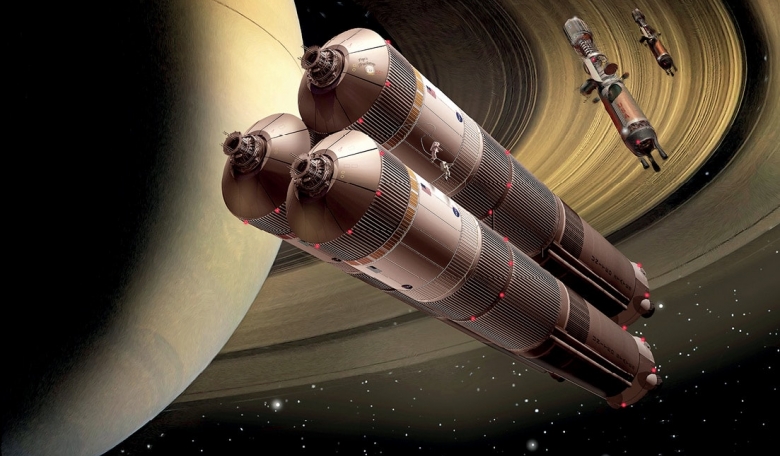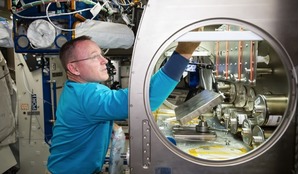Technological progress is exponential and in the next two decades areas like gene therapy, neuroscience, artificial intelligence, nanotechnology, advanced robotics and automation are all likely to converge. Such advances will fundamentally disrupt society as we know it. Autonomous decision-making systems and machines will be the big game changer, and making choices about our future will become difficult as technology replaces major human decision-making. Didier Schmitt raises the prospect of a future where technology becomes less subjugated to humans as humans become more subjugated to technology. He argues that it is a dilemma the public at large must be fully conscious of so that society can anticipate rather than become enslaved by technology. In essence he is talking about shaping the future and not being shaped by it - and in this exclusive extract from Scion|ce the author casts his retrospective, imaginative space eye back from the future.
The general public’s interest in space activities has always been present and ‘useful space’ came from an unexpected direction. Who indeed could have foreseen that the competition born of Cold War that carried the first men into Earth orbit would one day be replaced by international cooperation?
This was the case with regard to the International Space Station (ISS), the starting point for a real multi-national cooperation project. There were highlights that caught global attention such as when Philae landed on a comet in 2014, and then half a century later when a mini submarine was successfully plunged under the ice of Europa, a satellite of Jupiter. A great moment of political unification. This technology was not a special achievement, because the autonomous submarines had already taken over under our terrestrial seas and oceans, but it still needed a mini-nuclear generator to melt the 2 km ice sheet at -160 degrees Celsius.


Real change emerged when a common, very long-term vision was sketched out with the citizen participation of all nationalities, a fine example of crowd-shaping - participatory shaping - of public policy. The virtual representations gave a significant boost to this rush towards space. But let us not forget the dreams that such missions inspire. Proof of that was provided during the capture of the first asteroid by the crew of Orion; an event followed by more than four billion spectators in immers’Vision.
A few years later some six billion people ‘lived’ the descent of ‘marsonautes’ into Gale Crater. For a moment we had forgotten the ultimate goal: to find traces of proto-thermal bacteria based on triple-stranded DNA. Six months later, this historical discovery was confirmed by the automatic mission which returned with samples. In the high security P5 laboratory, the very definition of life was questioned and the Nobel Prize was not long in coming. This upset the mental representation of what makes mankind, as well as our place in this universe. It is now certain that other forms of life exist on some of the three billion planets registered in inhabitable areas of nearby galaxies.
Space dividend
“It is difficult to look further than you see” - Winston Churchill
A posteriori we now realise that the cost of these excursions in the sidereal vacuum has always been negligible compared to the expenses of past military conflicts. At the beginning of the century, these expenditures were compared to a cinema ticket or a pack of cigarettes as the equivalent of the annual contribution per person and per participating country.
Such comparisons no longer make any sense, not because tobacco and cinemas have long since disappeared but because of the indirect benefits of ‘pacification’ by the transnational links they create. This was called the space dividend.
Enthusiasm went as far as to generate philanthropic and participatory co-funding to see ideas become reality when those ideas were not necessarily a priority for scientists or politicians. All continents were represented in one or another initiative, with participation going well beyond the initial 30 contributing countries. The public’s enthusiasm grew as adventures were experienced through ever more realistic holographic communications.
The peak of attention was reached when we approached a catastrophe due to a dust cyclone at the advanced Martian base. It was an Apollo 13 adventure to the power of ten. Having missed their return window, the crew was forced to stay 500 more days. They were unable to rendezvous with the comings and goings of the ‘Earth-Mars’ cycler which, with its magnetron resonance propulsion, has an elliptical orbit and works as a shuttle that never stops.
Fortunately, the experiments of the polar bases influenced the concept of the Martian base, leading to a base design in which not all tasks were automated, mainly to keep the crew occupied and empowered but also to ensure the repair of the vital elements of the station. A 3D printer saved the mission.
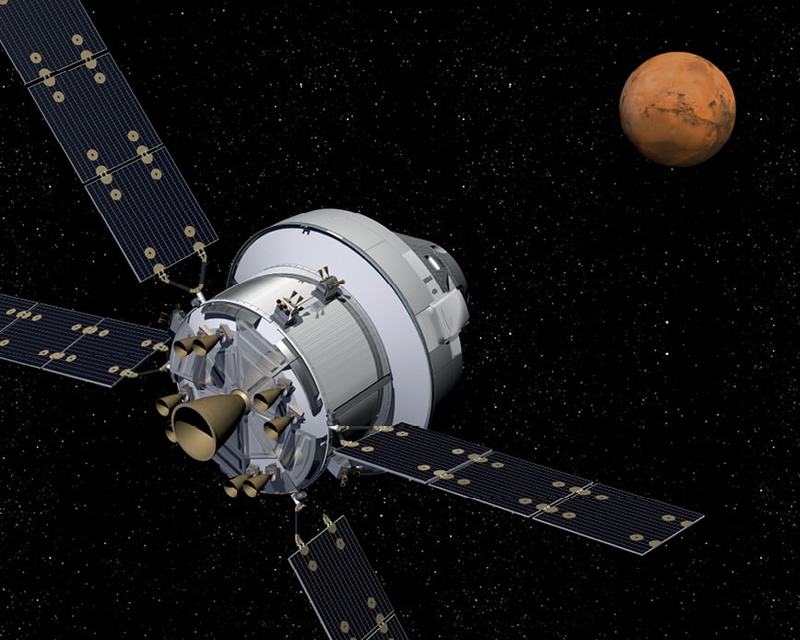 The Orion spacecraft - a key to future outer space exploration.
The Orion spacecraft - a key to future outer space exploration.
A lunar tourist
The return to the Moon has been a political and strategic debate because arguments in favour of the need for technological validation before going to Mars were dubious. The Chinese decided to make it a showcase of their technical competence and political power. Other space agencies had developed detailed plans for a permanent base to better prepare future missions to Mars.
“When someone states that something is possible he is almost certainly right, when someone says something is impossible he is probably wrong” - Arthur C Clarke
But the exorbitant cost just to carry out tests under conditions very different from the Martian surface and atmosphere became the Achilles’ heel of the plan and public opinion put paid to the idea. Nevertheless, European industry found the opportunity to showcase its know-how by embarking on a commercial Moon adventure with funds from Middle East countries which also needed international visibility.
The first lunar tourist was a landmark moment because it was all visible using telescopes from Earth, ruling out any attempt to deny the reality of this trip, as had been the case for NASA’s first lunar expeditions. In fact, tourism had developed in low Earth orbit (LEO) for two decades but setting foot on the Moon was reserved for a professional elite.
The availability of the Chinese station for the benefit of the international community from 2027 onwards was a trigger for this market. The ISS was thus entirely reserved for ‘scientific’ tourists, who thereby became its operators and guinea pigs. The professional crew, which operated it and ensured its security, remained on board for three consecutive years, which enabled them to study countermeasures for the Martian missions. And for those who wanted strong sensations there was always the extra-stratospheric solo return glide at supersonic speed.
Terraforming
In the same vein, the battle of principle continues for the followers of Martian terraforming. They have already raised funds for ‘seeding’ synthetic photo bacteria in those numerous places where salt water is present in summer. They would produce oxygen which will generate a greenhouse effect within half a century and could thus make the planet habitable, ultimately without the need for the inhabitants to wear spacesuits. To draw the attention of a reluctant audience to the subject of colonisation, the scien’Twists are already announcing a lottery for one-way trips to the Red Planet.
The last word for the already convinced public was the recent fortuitous discovery of the habitable exoplanet Gamma2042. An exploratory journey is not yet on the agenda, even though the scientific grail of dark matter has finally been found and the existence of space-time gaps identified with certainty by astrophysicists. It will probably be necessary to wait until the next century to attempt a breakthrough because, in parallel, there is still work to be done on the stabilisation of antimatter. Which means that the youngest of us will see such an expedition!
Meanwhile, the enigma of the recent atmospheric oxygen loss of G2033 still remains to be elucidated. A real mystery, since this phenomenon occurred in less than three years. No explanation can be advanced before the quark telescope is put into operation near the Lagrange point 5, in the wake of Earth. But everyone has in mind the high probability of extraterrestrial life having failed in some way. In this context, it is significant that just 50 years ago we did not even know about the existence of exoplanets.
 Animal bay on a futuristic spaceship.
Animal bay on a futuristic spaceship.
Planetary exploration
The collection of data on Saturn’s rings is done with hundreds of probes inspecting their rocks. The atmosphere of Venus is modelled with the aid of autonomous aer’Bots which drift with the winds. Following the characterisation of gravitational waves by the eli’Sa mission in the 2030s, radio telescopes scrutinise the depths of our universe in order to understand the nature of the shock waves coming probably from the neighbouring universe.
We have just celebrated 400 years of Galileo’s prosecution for his demonstration of heliocentrism and we will soon commemorate the hundredth anniversary of the first artificial satellite, Sputnik. But there is still so much to understand.
In the past, space programmes were designed for 30 years ahead. For the ISS, for example, the design, construction and operation took 10, 10 and 30 years respectively. But as in other areas, everything suddenly accelerated. It began with private initiatives decades ago, as with the constellations of thousands of satellites for the then internet 3.0. These private low-cost programmes of the time surprised everyone, especially the ones reaching space and then the trans-atmospheric flights. It should be said that these would not have come into existence without the strato’S horizontal take-off and landing rocket plane. All space programmes were boosted because the price of access to Earth orbit decreased to a fourth of its initial value.
 On Earth as it is on Mars - Earth’s martian science city.
On Earth as it is on Mars - Earth’s martian science city.
Mineral resources
“As for the future, it is not a question of foreseeing it, but of making it possible” Antoine de Saint-Exupery
But this was also at the origin of a number of challenges such as the one about the use of mineral resources of asteroids. These initiatives - driven by purely private interests - gave rise to unexpected opposition by ‘citizens of the world’.
These very people prohibited the exploitation of the Moon by classifying it as a ‘world heritage’ site. The combined effect of the movement for the preservation of celestial objects and the universal momentum for total recycling of rare elements definitely blocked those projects, even though they were already well advanced.
It is true that the international guidelines on recycling boosted innovation. Returning to minerals would have pushed us back into a waste era that was definitely thought to be over.
This shows that the concept of a service society and the priority given to ‘being and not having’ are now firmly rooted. The company or’Bit finally gave up after a fatal accident occurred during the wrapping of a small comet that began to spray a pocket of water on contact with solar rays. We were more or less accustomed to deadly accidents during take-offs and landings, but not to the fact of having to bring back the body of an explorer. The reputation of the company had already fallen after the discovery of genetic manipulations on the astero’Nautes so that they were more resistant to radiation and were cognitively more efficient. These difficulties show clearly that Earth will remain our living space for a long time.
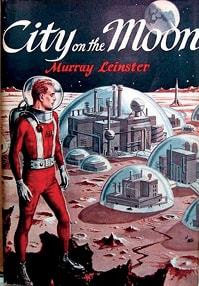
Narrow escape
However, the technology of connecting and docking these interstellar dinosaurs turned out to be beneficial when the comet AL318 was discovered by the amateur network damus’Nostra. Thus, everything was in place for the deviation of its trajectory, as the yotta’Flop supercomputer estimated the probability of the comet’s impact on the South Atlantic to be 99.9 percent. The 250 m tall tsunami would have forever changed the face of our planet. Since then, no one has ever questioned space budgets!
We narrowly escaped another cataclysm: a chain reaction of orbital debris. The alarm bell could have been sounded back in the 2020s but because of the competition on the costs of satellites no one wanted to take a first step to remedy the situation.
This time the decisions were immediate, as it was also necessary to urgently activate the ecliptic plan of the Beta tourist station, owned by the company or’Bit. Nobody can imagine the economic and societal cataclysm that would have resulted from the destruction of half of our space potential of 5,000 microsatellites.
It is true that we tend to forget what is not physically on Earth. If the domino effect had occurred beyond 600 km, the orbital slots would have been unusable until the end of this century. The million pieces of debris could never have been cleaned, even with the international programme clean’Space designed to capture and take old satellites out of service. And yet this technological weakness of our society was known.
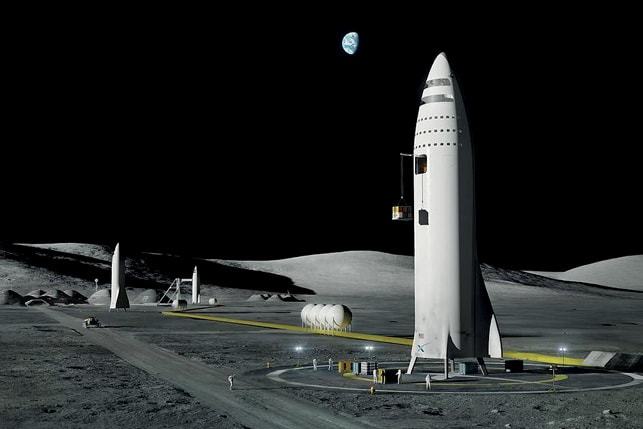 Lunar future.
Lunar future.
Climate forecasting
The met’Sat one-month forecast of air quality and rainfall allowed a giant leap forward in anticipating seasonal disasters and mobilising the global fund for climate nomads - there are already 150 million of them.
If this progress had been made 20 years earlier, we would have avoided many setbacks. Indeed, the true revolution was the environmental awareness that followed the real-time modelling of oceanic, terrestrial and atmospheric systems by merging spatial and aerial data - obtained via pico-drones in a swarm - along with terrestrial data obtained by crowdsourcing from millions of ‘citizen sensors’.
What would this modelling actually be without the sharing of geo’Synchron real-time video observations? The digitization of the planet led to the extinction of the last climate-sceptical Mohicans. Let us note that it was necessary to stop the Oogle type hegemonies by classifying the continuous flow of satellite images as open’Access world heritage.
Other applications blossomed, such as the ones focused on the optimisation of eco-agriculture, the management of multiple energies, environmental-dependent health issues or the monitoring of ecosystems by the patri’Ot citizen association. The term ‘space applications’ has definitely become obsolete because all these observation systems are part of a continuum.

Technological warfare
“The best way to predict your future is to create it” - Peter F. Drucker
The superiority of space systems over any other form of technological warfare exposed the fragility of our society. The escalation between attack and defence systems of satellites was quickly pointed out as being strategically unsustainable.
The interweaving of civil and military systems had become such that each hostility could lead to a cascade as in the era of nuclear deterrence. This was voluntary, since civil aircraft and combat drones were navigated from the same satellites. Despite this, advocates of the concept of ‘deterrence by dependence’ struggled at first to make their point.
The aim was to render obsolete the race for technologies to neutralise opposing space systems because of the unacceptable consequences in all civilian sectors of a ‘spatialised conflict’. The balance of fear was the only solution, given that codes of good conduct and other international agreements never succeeded because they were so easily circumvented. But above all, it was necessary to accept the new evidence of a common adversary that emerged: cyberterrorism 4.0, which found a gap in the quantum networks.
It began to do more harm than the conflicts of the 20th century and only a collective and global response could stem it. Each object, portable or not, has long been geo-locatable in order to be part of the Internet of Things. The dependence on satellites had also become too great, so that alternative location geo’Loc microchips - in a network integrated by the internet - had to be invented to avoid the risk of an economic collapse if satellites were put out of service for one reason or another. Alternative solutions have also emerged, such as relay nanosatellites capable of being orbited in their hundreds if necessary.
The fusion of civil and military space programmes ultimately confirmed the protection of Earth’s orbit as a ‘common good’.
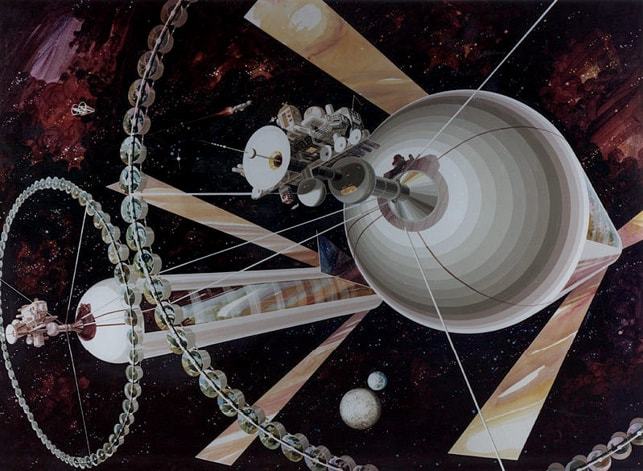
About the author
Didier Schmitt was scientific adviser and foresight coordinator in the Bureau of European Policy Advisers to the President of the European Commission (2012-14) and worked in the Space Policy Unit at the European Commission from 2009-12. At the European Space Agency he managed human and robotic exploration preparation programmes, including the use of the International Space Station (1997-2009). In his academic career, he was associate professor at the Toulouse medical school and the International Space University (1992-1997). His educational background is a PhD in biosciences in addition to being a certified medical doctor. Currently working in the European Union diplomatic service, he is a regular opinion writer in mainstream French newspapers on future issues in science, technology and policy.





